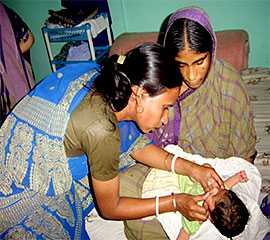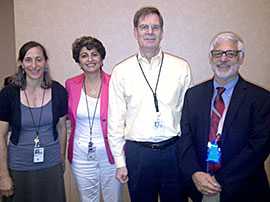ANISA Statistics, Plikaytis Retirement
This website is archived for historical purposes and is no longer being maintained or updated.
January 14, 2014: Content on this page kept for historical reasons.
In This Issue
- DBD Labs Pass CLIA
- On Call for Diphtheria, MERS
- ANISA Statistics, Plikaytis Retirement
- Vaccine News, Awards
- Communications
- Publications
- Epi-Aids, Meetings, Resistance Report
- Calendar
Division of Bacterial Diseases (DBD) News Bulletin
Fall 2013
Applying New Statistical Tools to ANISA
Of children younger than five years old who die in the South Asian countries of Bangladesh, Pakistan, and India, 40% are neonatal deaths. Newborn deaths in these three countries alone account for more than a third of all neonatal deaths around the world. In developing countries, infections are one of the top three causes of neonatal deaths, but there is not much data demonstrating which pathogens are responsible. To help answer that question, the Aetiology of Neonatal Infections in South Asia (ANISA) project was launched in 2011.
Funded by the Bill & Melinda Gates Foundation, the study aims to improve neonatal survival in the region and beyond by describing etiology of community-acquired newborn infections, antibiotic sensitivity of bacterial pathogens, and risk fac¬tors for infection. DBD scientist Stephanie Schrag is a co-principal investigator of ANISA, with statistician Nong Shang and several key laboratory staff (led by Jonas Winchell, Maureen Diaz and Lesley McGee) integrally involved. Stay tuned for a future story about the extensive lab efforts related to ANISA.

Photo: Two community health workers assess a newborn in the Sylhet site in Bangladesh. Photo courtesy of the Sylhet ANISA site.
As part of ANISA, every woman between the ages of 14 and 49 in selected urban and rural communities of Bangladesh, Pakistan, and India is being monitored by local health workers—seeing who gets pregnant and following up on their pregnancy, childbirth, and post-natal period. In addition to collecting information on risk factors for neonatal infection, the health workers provide the expectant mothers with basic prenatal care and aim to see each mother during the first 24 hours after childbirth. Babies with an infection are referred for immediate care to designated study facilities. Once there, blood samples and nasal and throat swabs are collected from the newborns.
After samples are collected and processed, the statistical analysis can begin. The goal is to construct a pathogen pie, or frequency distribution of individual pathogens, among the children with sepsis in the study population. The results will then be used to guide policymakers in planning public health interventions, such as development of new vaccines and treatments.
However, ANISA is not without analytic difficulties. The most challenging issue when it comes to the analysis is how to develop a method to correctly estimate the fraction of disease due to certain pathogens when there is no gold standard to identify which pathogen is causing the disease. Due to limitations with laboratory testing methods, and even more importantly the challenge of sampling the actual site of infection (for neonatal sepsis this could be blood, cerebrospinal fluid, lung aspirate, or urine) researchers need to come up with a plan for preventing biased estimation of the pathogen distribution.
Another serious challenge is obtaining the needed sample size and quality of specimens from the healthy babies selected as controls. Different statistical approaches will be explored to adjust the bias from such controls. With many other potential challenges to contend with, the complexity of the analysis substantially increases.
These challenges are exciting for the researchers planning the analysis. Nong said, “I’m eager to address methodological challenges by developing powerful and useful tools for one of the largest etiology studies. The study has great potential to improve lives of millions of newborn babies and to understand the nature of sepsis.”
The analysis plan tries to combine all aspects of the project—case definition, control selection and adjustment, and laboratory techniques—into an integrated statistical model by applying modern yet standardized statistical tools. It is not often that a research project has final outcomes that depend strongly on applying new statistical tools. As a result, there are many challenges involved in the implementation process. Great progress has already been made in resolving these challenges and the experience will provide insights to improve future project design and optimize laboratory techniques.
The ANISA team developed an analysis plan for etiology attribution, the primary objective of the project. This analysis plan was discussed and well-received during the Third ANISA Investigator Conference in early November; CDC will continue to lead the analysis finalization and implementation.
Retirement of Brian Plikaytis

Photo: DBD hosted a retirement party for Brian that was attended by many colleagues, some of whom worked with Brian over 30 years ago. Pictured here is Brian (second from right) at the party with Stephanie Schrag, Rana Hajjeh, and Bob Pinner.
Brian Plikaytis, M.Sc., retired from CDC after 36 years of service on September 3, 2013. Brian was chief of the Biostatistics Office, Division of Bacterial Diseases, National Center for Immunization and Respiratory Diseases. During his career at CDC—as a mathematical statistician, activity chief, section/office chief, and branch chief—he focused on study design and advanced statistical analyses for multiple bacterial and fungal infectious diseases of public health importance, with a special emphasis on vaccine development, evaluation, and research, and standardization and validation of laboratory diagnostic and immunologic tests.
Most recently, Brian has been the senior advisor for biostatistics for the Meningitis Vaccine Project, focusing on the development, evaluation and licensure of a meningococcal conjugate vaccine that aims at eliminating the devastating meningitis epidemics in the meningitis belt of sub-Saharan Africa, and that has so far proven very successful.
About his career at CDC and plans for life after CDC, Brian says, “With my undergraduate degree in a laboratory science and graduate degree in biostatistics, it would be difficult to imagine a job more well-suited to my skills set than the one I’ve enjoyed here at the CDC. I feel extraordinarily fortunate to have the opportunity to work with so many smart and talented people on projects with such high degrees of public health impact.” Brian plans to continue his professional collaborations with present and former clients as a statistical consultant.
- Page last reviewed: January 14, 2014 (archived document)
- Content source:


 ShareCompartir
ShareCompartir